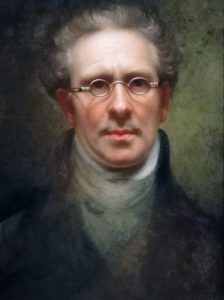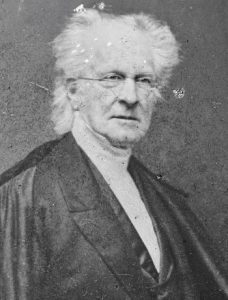A Tree Found, Tried & Shook
Since we are well into “apple season” here in New England (as well as in neighboring New York State, the country’s second biggest apple-producer), the title phrase of this week’s blog—plucked from a P. T. Barnum letter—seemed ripe for picking. Writing from France to his American Museum manager Fordyce Hitchcock on September 12th, 1845, Barnum commented, “No, my dear H, the Museum, like Tom Thumb (2 years ago), is a tree found, tried & shook. There is nothing now to do but pick up the fruit . . . .” These may sound like the words of a man well-satisfied with his achievements, but as we’ll see in letters written only about six weeks later, Barnum was not at all ready to sit back and just let the fruit fall. No, he was gathering ambitions by the bushel, and these were sustained by artful strategies and calculations, not just wishful thinking. No doubt he lay awake many a night mapping out an ever-wider road to success. Barnum admitted to his uncle in the postscript to his letter of October 23rd, “My brain is bursting with confusion & a multiplicity of affairs & this must be my apology—I hope you’ll not think I am crazy, for really I believe I am not, though I am nearly next door to it.”
The “multiplicity of affairs” is certainly one of the challenges and delights of reading Barnum’s copybook letters, especially now we’ve come this far, about a third of the way through the volume. Never short on words, Barnum gives us a lot to unpack in almost every letter. And because of the rich content, I now find myself looking back more and more to earlier letters so as to “connect the dots” with new information I find. This iterative process, whereby we are building our understanding of 35-year-old Barnum, requires patience, but the rewards are well worth it as more things start to “click.” I expect this process will become even more interesting as we continue on!
This week we’ll tap into the aforementioned September letter to Hitchcock, “pairing” it with the October 23rd letter to Alanson Taylor, a maternal-side uncle with whom Barnum had worked for many years. Both of these are well worth reading in their entirety, though fair warning: one is eight pages and the other, six.
There are several reasons aside from length that these letters offers so much. First, Barnum consistently shared his views and “gut” feelings with certain correspondents, especially his uncle Taylor, Hitchcock, and showman competitor-friend Moses Kimball. He is quite open and honest with them so far as we can tell (maybe not entirely so with Kimball), and thus provides us a window into his mind, far more than most letter writers who stick to conveying basic information. Second, Barnum had a close relationship with his uncle—though he vehemently disagreed with him on matters of religion—and with Hitchcock, whom he completely trusted; however, those two men did not always see eye to eye and Barnum found himself in the role of peacemaker, begging them to see that getting along was to their mutual advantage. Third, Alanson Taylor is a “hybrid” among the cast of characters in the copybook, being both a family member and a business associate/partner. Topics, therefore, reflect both family and business concerns, and in those days personal and business finances seem to have been managed in a more fluid fashion with assets co-mingled, thus Hitchcock held the purse-strings in Barnum’s absence.
For now, we’ll focus on learning about Barnum’s present and future business plans, for as he wrote to his uncle,
“You know that my general fault has been my proneness to tell other people my plans & expose my business—[but] I fear that in the present case, I have erred on the other side, for had I told you and Hitchcock my plans, it would have saved a little development which I fear has now occurred in my affairs—but which I hope after all is not of much consequence. But here were my plans & you can judge after reading this whether they have put me in a fix or not.

The issue in question was the purchase of Peale’s museum in Baltimore, Maryland. Barnum freely admitted to his uncle,
I have always been vexed at myself for not having bought the Baltimore Museum for you and as my prosperity has advanced I have been trying to make up for that misstep. Fearing that your cloth trade was not turning out very lucrative—I determined to build and open an opposition Museum in Baltimore, by which I felt sure of killing Peale & then buying his stock for N. Orleans or some other city. I intended you should have had half the museum if you wished. I never breathed this plan to a living being except Stratton & he at once proposed coming in thirds & popping in Tom Thumb for a portion of the time to pay for the privilege of becoming a partner. I half thought that such an arrangement might be contrived for your & my benefit & I told Stratton I guessed we could so contrive it.

Unbeknownst to Barnum—until he received a letter from Taylor—his uncle had been working on his own to acquire a half ownership in Peale’s Baltimore Museum. Barnum had mixed feelings about this, telling his uncle, “I hope that you will not long be chained to that rascal Peale—for he is a thorough-bred scamp & no mistake.”
Barnum, meanwhile, had been advising Hitchcock about buying the Peale museum (collection) in New York City, though only to have Mon. Guillaudeu, the museum’s naturalist, box it up and put it in storage, “except any specimens which may show well in the [American] Museum.” It was his back-up plan, as Barnum explained to Taylor, “fearing the American Museum might burn down & find me without the stuff for another.” At that point, the New York Peale’s Museum was in the hands of one Seaman, who was asking $8000 for it. Barnum strongly preferred to pay less ($6000 to $7000), and thought that if Seaman held out, Hitchcock should go to Philadelphia to see about acquiring the (original) Peale’s museum there. (That said, Barnum had given Hitchcock permission to offer $8000 to Seaman if absolutely necessary. He was gambling on Hitchcock not ending up with two major purchases simultaneously!) With three different Peale collections in the mix here, and Barnum overseas, uncertain of what was or was not happening, it gets very confusing. I have to agree with Barnum’s acknowledgement of his role in potentially creating, as he called it, “a mixed up bothering affair.” In any case, Barnum explained his motive to Taylor thusly,

As for my ultimately getting a finger in the Baltimore Museum I do not in the least desire it unless doing so would be for your interest. My present idea is that it is necessary for me to have an interest in several Museums in as many cities, so as to be able to engage such novelties as are necessary & which one museum alone could not afford to engage.
Further, he saw opportunities for acquiring more interesting “novelties” in Europe that would draw American audiences. Again to Taylor he wrote, “. . . if I have an interest in several museums, as I soon shall have if I live, I can the better afford to procure novelties in Europe.” Being far from home and often on his own as the advance man for the Gen. Tom Thumb tour, Barnum had time to percolate schemes and strategies, considering ways to expand his operations far beyond Broadway and Ann Street in Lower Manhattan. Barnum was nothing if not a risk-taker. Nonetheless he remained dedicated to his beloved American Museum. As he explained to Hitchcock in a September 12th letter,
I bought the museum originally for $12,000—should a stranger come to me tomorrow with $100,000 cash in hand I would not accept it for the [American] Museum! This at first sight looks foolish. And if I had no other money in the world it would be so—for in that case I should say give me the 100,000 for by so doing I secure an independence & thus part with an uncertainty for a certainty. But now it is different—now I would say, I already have an independence & therefore should be foolish to sell property for a sum which would produce me but 7000 [dollars in interest] per year, while the probability is that same property will produce double the amount yearly. Why should I not keep the property & stand the chance of gaining this double-amount—since I can afford to run the risque.
Barnum also considered his work to enhance the American Museum vital to his psyche. To Hitchcock he opined, “If it could be proved that a man could enjoy himself better by ‘retiring’ as it is called, and being idle, than by being occupied, there might be an inducement for me to sell out, but as it is very evident that a man of my disposition would be happier in attending to that museum than in being idle, I have no excuse for parting with that profitable source of amusement.” And so he continued, and with the fruits of his labor, his tree “found, tried & shook” eventually turned into an orchard.
Adrienne Saint-Pierre
Barnum Museum Curator

